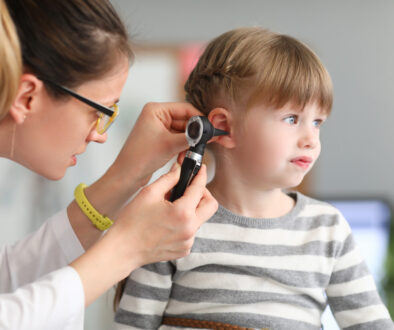Why Do Children Get So Many Ear Infections?
lmost every parent knows the stress and anxiety that occurs when your child has an ear infection. It seems like these chronic infections are almost a rite of passage during childhood. While there are several treatments for children who have chronic ear infections, including ear tubes, you may be wondering: Why do children get so many ear infections in the first place?
The key lies within the anatomy of the ear. Children’s ears are very different from adults’. But first, here are two words and definitions you will find useful when discussing ear infections:
Eustachian Tubes
These are a pair of narrow tubes that run from the middle ear to the back of the throat. The tubes open and close to regulate pressure in the middle ear and drain normal secretions form the middle ear.
Adenoids
Adenoids function similar to lymph nodes. They are located high in the throat behind the nose and the roof of the mouth. They can only be seen by using special instruments. Their job is to fight infections. They do this by trapping germs that enter the body. As a result, they temporarily swell when they try to fight infections. Chronic tonsillitis and infections can make the adenoids sore and swollen.
Why are children more likely to get ear infections?
Children’s Eustachian tubes are smaller and more level than the ones in adults. This means that even under normal circumstances it’s difficult for fluid to drain from the ear. If the tubes are swollen or blocked due to a cold or infection, fluid drainage may be even more problematic.
Children’s immune systems aren’t fully developed, so it’s more difficult for them to fight infection. They may also get colds more often. If they develop an infection, swollen adenoids interfere with the body’s ability to ventilate the middle ear, which can cause infections or, in some cases, temporary hearing loss.
What are the signs of an ear infection?
Obviously, infants and younger children will not be able to tell you that their ears hurt, so you should watch for the following signs:
- Tugging or pulling at his or her ears
- Trouble sleeping
- Clumsiness or problems with balance
- Difficulty hearing quiet sounds.
- Fever, particularly in infants and younger children
Can ear infections be prevented?
It may seem impossible to prevent ear infections, particularly with all the germs children are exposed to at school or day care centers. However, you can reduce your child’s chance of getting an ear infection by taking some of the following steps:
- Vaccinate your child against the flu and make sure he or she gets the vaccination every year.
- Speak to your doctor about other vaccinations such as the pneumococcal conjugate vaccine that protects against several types of infection.
- Wash your hands frequently. Teach your child how to wash hands properly with soap and warm water.
- Avoid exposing your baby to cigarette smoke. Babies who are around smokers have more ear infections.
- Never put your baby down for a nap or for bedtime with a bottle.
- Don’t allow sick children to spend time together. As much as possible, limit your child’s exposure to other children when your child or your child’s playmates are sick.
How can I tell if my child has an ear infection?
Most ear infections happen to children before they’ve learned how to talk. If your child isn’t old enough to say “My ear hurts,” here are a few things to look for:
- Tugging or pulling at the ear(s)
- Fussiness and crying
- Trouble sleeping
- Fever (especially in infants and younger children)
- Fluid draining from the ear
What causes an ear infection?
An ear infection usually is caused by bacteria and often begins after a child has had a sore throat, cold, or other upper respiratory infection. If the upper respiratory infection is bacterial, these same bacteria may spread to the middle ear; if the upper respiratory infection is caused by a virus, such as a cold, bacteria may be drawn to the microbe-friendly environment and move into the middle ear as a secondary infection. Because of the infection, fluid builds up behind the eardrum.
Because ear infections are so common, it’s important that your child’s ENT doctor specializes in pediatric ENT. At Raleigh Capitol Ear, Nose & Throat, we have treated hundreds of children throughout the Triangle area.
If you suspect your child has an ear infection, please contact us to schedule an appointment.
Sources:
National Institute of Health. “Ear Infections in Children.” Online.
Nemours. Kid’s Health. “Enlarged Adenoids.” Online.
The Mayo Clinic. “Ear Infections: Symptoms / Causes.” Online.
« How to Stop SnoringThree Ways to Know if You Need a Hearing Test »
The 4 Most Common Problems Affecting the Ears
Is There a Connection Between Hearing Loss and Dementia?
Do You Hear What I Hear? 6 Tips for Communicating with the Hard of Hearing
Three Ways to Know if You Need a Hearing Test
How Do Hearing Aids Work?
Comments are closed for this post, but if you have spotted an error or have additional info that you think should be in this post, feel free to contact us.




